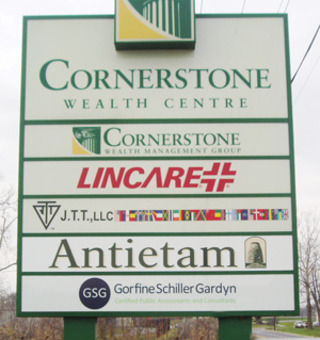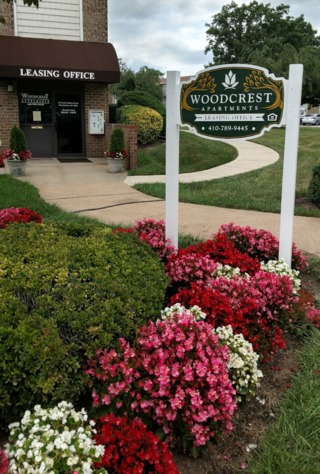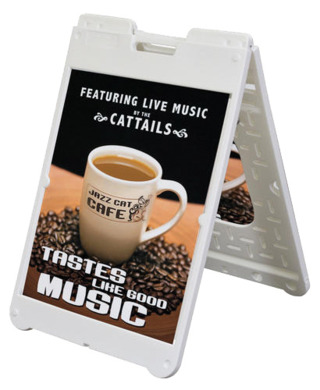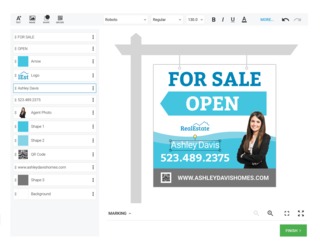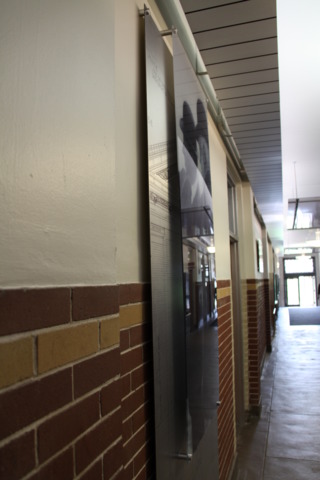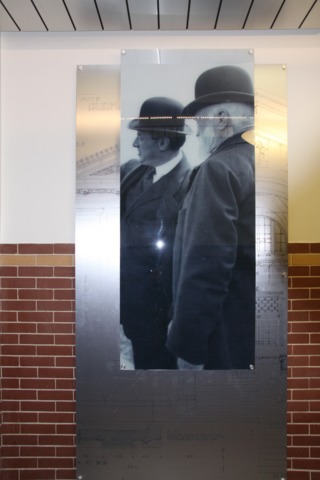Hard Signage: Here, There, Everywhere
Customers are looking for high quality and standing out from the rest takes moving beyond the basics.
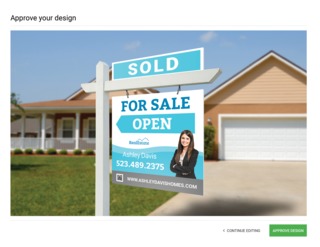
Hard signage is often much more than its name suggests: it’s actually a branding agent. For a retail operation, a sign in the shop window is often the first impression of a business experienced by a customer. An effective sign helps capture the attention of shoppers, and can help to drive more sales.
Hard signage is all over the place, both in terms of sheer volume and in type. For one thing, hard signage is ubiquitous, so much so that we are not even aware of how much we come across on any given day. And with today’s direct-to-substrate wide-format printers, nearly any surface can be used.
Hard signage is purchased by a variety of businesses from banks and universities, to public venues, hospitals, real estate companies, and private businesses, from small start-ups to large corporate entities.
"There are so many types of materials, offering greater flexibility for many applications," said John Dziak, CEO, Printscape Imaging & Graphics. “The challenge is to ensure that you use the right material and process to provide a quality product. The opportunity is that we can sell hard-signage to nearly everyone because we are not limited to the basic substrates.”
Customers are looking beyond high quality, to the use of more exotic materials, such as brushed aluminum, acrylics, wood, magnetic substrates, and metal. "There is a shift toward the use of acrylics and metal materials," noted Dziak.
At Strategic Factory, “we are seeing an increase in coroplast, aluminum, banners and post and panel signs, as well as vehicle wraps,” said Jen Scott, senior project planner, Signage.
Hard signage can be hung inside or outside, be permanent or intended for a particular event.
Because budget is always a consideration, economy brand products that can be used for a variety of purposes seem to be popular. “Coroplast, alhough not the most elegant or ‘permanent,’ is still a popular signage material due to the fast turnaround time/quick use requirement for many of our client requests,” acknowledged Scott.
"A trend for smaller signage that we’re seeing is the use of materials for a variety of purposes," added Jason Odam, signage strategist, Strategic Factory. “For instance, we’re using Dibond (or other ACM products), for not only exterior real estate signs and parking signs, but also interior directional signage and office uses.”
Substrates that are capable of direct-to-surface printing are almost a required standard to keep up with large-format printing and dimensional fabrication—not a new phenomenon, but ones with expanding borders.
“As signage trends focus on creating larger and digital materials, the challenge is to keep up with that demand with increased signage capabilities,” explained Odam. “Obtaining larger, faster and more versatile equipment and machines that meet ADA project requirements can be a challenge, as well as having enough industry professionals on-hand to produce and install these jobs.”
Sign providers need to push the boundaries of digital printing and material to provide a high-end sign that doesn’t pass the due date or break the bank.
“One fantastic opportunity for printers is that it keeps getting easier and easier to expand into the signage world with the ability to print direct to substrate,” said Scott. “ You can also creatively expand into other areas—including awards and centerpieces—simply by printing on acrylic, custom contour cutting, and bonding items together.”
Strategic Factory
Operating since 1999, the company expanded its signage capabilities when it opened its 40,000 square-foot production facility, Strategic Factory, in 2015.
Located in Owings Mills, MD, Strategic Factory serves accounts locally and nationally. “We support all types of businesses, from one-man shops to multi-location corporations,” said Scott.
"The variety of our projects is limitless," added Scott. “We produce indoor signage including dimensional logos, plaques, standoff system signs, posters, wall wraps, elevator wraps, frosting, retractable banners, and more. With outdoor signage we typically produce banners, channel letters, metal signage for parking lots, coroplast signs, vehicle wraps, and storefront signage. We recently produced graphics for use inside a swimming pool! We receive a large amount of work from property management companies (or the tenants within those properties). Traditionally this includes directory signage, suite plaques for individual tenants, and interior lobby dimensional letters and graphics. If you have an 'out of the box' idea we can produce it. With our Esko MultiCUT the possibilities of contour cut shapes are endless.”
Printing this large variety of signage requires flatbed and roll printers, routers, engravers, painting equipment/facilities, and equipment capable of producing ADA-required details.
Strategic Factory’s current equipment list includes the following, but, said Odam, “we are continually adding and expanding:"
- Flatbed, Roll-to-Roll Printer, CNC Router, Plotter
- CANON imagePROGRAF iPF8400S large format printer
- Esko XN MultiCUT digital cutting table
- Fuji Acuity large format/flatbed printer
- Graphtec fc8600 cutting plotter
- Grommet Machine - Fasnap
- HP Latex 360 large format roll printer
- SEAL 64 Base mounter and laminator
- Titan Fletcher cutter/trimmer
To succeed in this business, “paying attention to the details and accurate planning is critical in producing quality hard signage products for clients,” Odam said. “Communication and upfront customer expectations is also key. Discussing the details and asking the right questions from the start, including end use, installation, etc., greatly determine a job’s path and what materials are ultimately suggested and used.”
Printscape Imaging & Graphics
Established in 1977 as Washington Reprographics, Printscape primarily focused on wide format document printing for the construction market. The name was later changed to reflect the changes in the market. Printscape, Inc. was born around 2004 and offered services to a wide array of vertical markets, including retail, secondary education, public venue, medical, and the energy sector.
Located out of two locations near Pittsburgh, PA, Printscape Imaging & Graphics, 75% of its revenue is generated regionally and 25% is national.
Printscape creates 3D in-store displays as well as large-format lifestyle and wall images, and offers custom exterior and interior retail signage in any size or shape. The company handles the entire project for its clients, coordinating printing, fulfilling, and installation for its customers. “Twenty-five percent of our business is providing national branding solutions,” says Dziak.
“We typically say, ‘If it will lay flat, we will print on it,’” Dziak commented. “Saying that, we do a lot of ADA compliant wayfinder and identification signage. We do a lot of printed metal, wood, acrylics, and printed films. Most of our work is geared at providing environmental branding solutions.”
To produce the signage, Printscape relies on several machines, including the Canon Arizona 350GT, Canon Arizona 480GT, Screen TruePress 2500, and HP Latex 360.
“The irony is that ‘flexibility’ is the key to success in the hard signage market,” he added. “ Don’t be afraid to try new materials, new processes, or go after some jobs that you normally would not pursue. Not every job is a fit but you don’t know until you try. Most times we can find a solution for the customer if we are willing to try new things.”
Dziak concluded, “Commitment to staying relevant in your space is key. We should always be looking ahead, asking questions, trying new things, and not be afraid to change. After that, you have to deliver.”
Web-to-print’s growing role in real estate signage
The signage industry is rather late in turning to web-to-print for solutions, and instead treats each order as a completely custom project. In many cases, it’s closer to making a custom piece of furniture than simply printing something out. However, there is one niche just ripe for the taking that will benefit both signage and web-to-print: real estate signage.
By integrating web-to-print into their platform, signage firms have something that real estate companies need: quick and cost effective brand management. Signage companies realize savings due to the minimal effort they will need to spend on future signage jobs. A sign company really only needs to make the initial standard templates for yard signs, direction signs, and even flyers. The realtors do the rest by entering their personal information, yet they also save time with 90% of the design already completed.
New web-to-print technologies also have tools that make it easier for realtors to keep branding consistent in line with the strict design parameters that real estate companies set for their signage. For example, one such web-to-print editor, Customer’s Canvas, has a system of markers that can be applied to a design template’s layers. Using these markers, companies can either allow or disallow certain changes to the design.
Signage firms can offer this service in the form of private customer portals for each of their realtor clients, or any customer customer for hard signage, such as hospitals or restaurants. Signage customers can access their own personalized storefront to download all of their branded materials. Orders can be placed in a matter of minutes and saved as a repeat order for the next time they need it.


